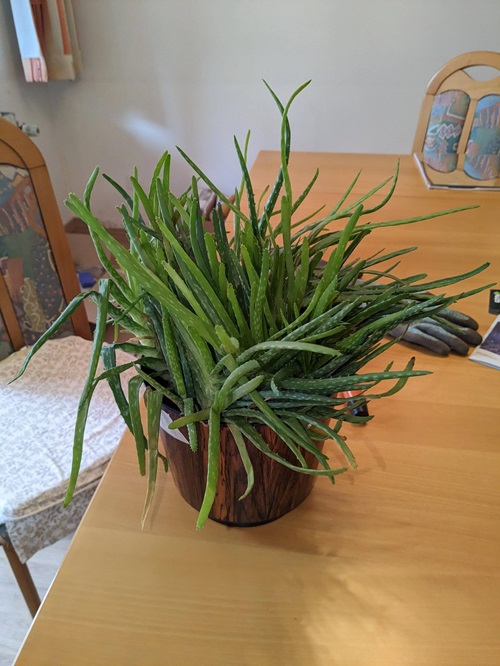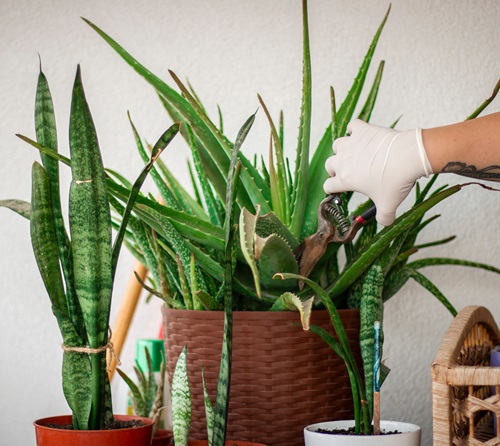This classic succulent is a true garden treasure, but it can grow out of control and become leggy! Here’s how to Fix an Overgrown Aloe.

Aloe vera is a hardy succulent known for its soothing gel, healing qualities, fleshy, serrated green leaves with white flecks, and upright habit. However, the plant may start spilling over or growing unruly for various reasons. Hence, we show you how to fix an overgrown aloe.
Why Does Your Aloe Grow Out of Control?
Aloe typically grows outwards from a central stalk—the backbone of the rosette arrangement of aloe vera leaves. And new growth spirals out from this center. Now, a few factors may lead to it growing out of control, toppling over, or getting leggy.
Not trimming the central stalk for a long time is a key cause. Aloe loves its personal space to bloom and groom itself. It vigorously produces offsets that vie for more space, sun, and nutrition, and these shoots will grow wild, out-competing the rest of the plant for resources.
So, an overgrown central stalk, a pot that is too small, and imbalanced light dispersal will lead to overcrowding, leggy, asymmetrical, and haphazard growth, and ultimately, your aloe’s ruin. These issues can be easily tackled by following our guide. Read on!
How to Fix an Overgrown Aloe
1. Divide the Pups
Aloe vera naturally produces pups or offsets—smaller plants that grow alongside the parent. So, if your mother plant is a bit overzealous and has quite a few pups to spare, propagate them into separate plants. Here’s what you do:
Pull apart the offsets gently from the plant or cut them from the roots with a sharp, clean knife, and snip off the dry tips with scissors.
Then, pot them up separately in a container that is big enough to accommodate their adult size to prevent overgrowth issues from recurring.
This frees up space for the parent to breathe while considerably expanding your aloe collection. It also reduces the risk of diseases.
Read this guide to learn more about aloe. You can also grow aloe from leaf cuttings—watch this video to learn how.
2. Rotate for Sunshine

Aloe leaves often stretch out in search of light, making the plant leggy, unstable, and asymmetrical.
One side of your plant may get some sun while the other bits are in the shade. So, while the part that gets light grows robust, the shaded sections turn stunted and lopsided.
The solution is easy—move the plant to a spot with bright, dappled sunshine. Otherwise, rotate the plant weekly to ensure all parts get their dose of sunlight.
3. Snip Away Extra Growth
Our final step in how to fix an overgrown aloe is pruning—and that isn’t just snipping away all the extra growth you see. It’s about getting rid of the old while nurturing the new.
Give your overgrown aloe a good trim by pruning fat or heavy leaves that are lopsided or hanging down.
Do this often in spring and summer, when the plant is in its active growth phase, and you can harvest it regularly for juices and other topical uses.
Use sharp, clean scissors to snip away old, withered leaves gently. Don’t get aggressive; this can hurt and stress your plant and hamper its well-being.
Also, avoid picking small and young leaves and let them grow. By trimming regularly, you can easily maintain the shape of your aloe plant.
Apart from these measures, you can also provide your plant with some support to help it grow upright.
Care Tips After Pruning
Your aloe plant will need some TLC after trims and snips. Here’s how to nurse your plant back to health.
- After pruning, water sparingly but always thoroughly and deeply. Overwatering can lead to root rot and make the plant vulnerable to disease and attacks by pests like mealybugs and aphids.
- Ensure it is not exposed to harsh sunlight, which can cause sunburn. Aloes enjoy dappled, gentle sunshine.
- Don’t try to shape or design the plant like a topiary. Instead, aim for a natural and tidy appearance rather than manicuring it since the plant is not meant for such designs!
- Do not over-prune. This will surely kill your plant. Here’s how to cut an aloe without destroying it.
And with this, your overgrown aloe will be back on track to looking and growing great! Let us know which of the three fixes worked for your plant in the comments below.



